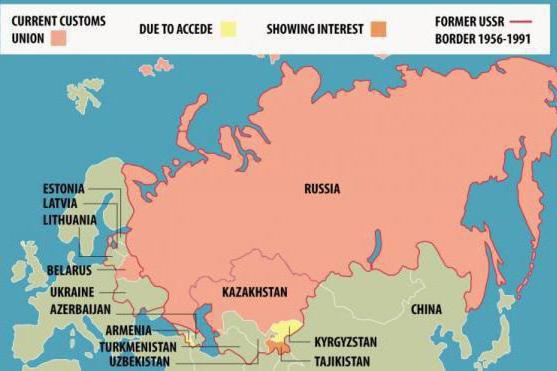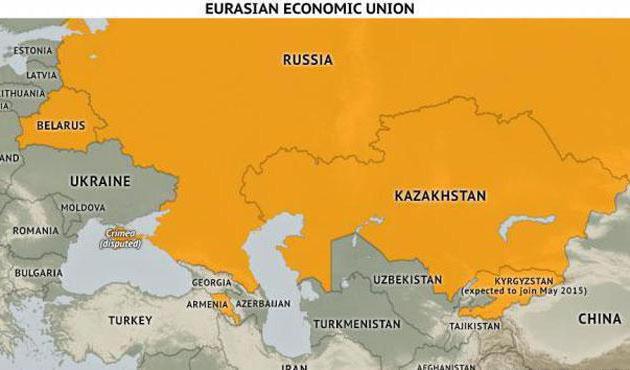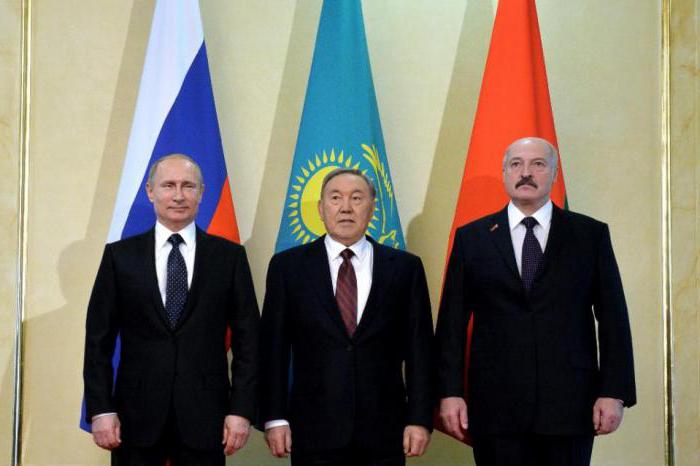The world every year goes further along the path of globalization and integration. Relations within economic and political unions are growing stronger, new interstate associations are appearing. One such organization is the Eurasian Economic Union (EAEU). Let's find out more about the work of this regional association.

The essence of the EAEU
What is the Eurasian Economic Union? This is an international association aimed at the economic integration of a number of countries located in Europe and Asia. Currently, it includes only a number of states of the former Soviet Union, but this does not mean that theoretically the EAEU cannot expand beyond the borders of the former USSR.
It should be noted that members of the Eurasian Economic Union are expanding cooperation among themselves, not only economically, but also politically and culturally.
Organization goals
The main goal set by the Eurasian Economic Union is to deepen economic cooperation between the countries included in it. This is expressed in local tasks, such as stimulating trade between countries, removing customs and tax restrictions on trade, developing cooperation and developing common economic projects. The result of deepening cooperation should be the growth of the economies of the participating countries and an increase in the standard of living of their citizens.

The main tool to achieve the strategic goal is to ensure free trade, which is expressed in the unhindered movement of commodity values, capital, labor and other resources within the borders of the EAEU.
Background of creation
Let's find out how an organization such as the Eurasian Economic Union was formed.
The beginning of the reintegration of states in the vast expanses of the former USSR was laid by the creation of the CIS. An agreement on the formation of this entity in December 1991 was signed between the heads of the RSFSR, Belarus and Ukraine. Later, until 1994, inclusive, all Soviet republics joined him, except for the Baltic countries. True, Turkmenistan takes part in the organization by association, the Ukrainian parliament has not ratified the agreement, therefore, although the country is the founder and member of the association, it is not legally its member, and Georgia left the CIS in 2008.
However, during their work, the institutions of the Commonwealth have shown their low efficiency. The decisions of the CIS bodies were not actually binding on its members and were often not implemented, and the economic effect of cooperation was minimal. This made the governments of some countries of the region think about creating more effective systems of interaction.
A statement on the need to create a closer union than the CIS, which would imply a systematic integration of the economies of the participating countries, as well as a common defense policy, was expressed by the President of Kazakhstan. By analogy with the European Union, he called the hypothetical organization the Eurasian Union. As you can see, the name stuck and in the future was used to create a new economic structure.
The next step on the path of mutual integration was the signing in 1996 between the leaders of Russia, Kazakhstan, Belarus, Kyrgyzstan and Kazakhstan of the Treaty on Deepening Integration. Its action covered both economic and humanitarian spheres.
EurAsEC - the predecessor of the EAEU
In 2001, the integration aspirations of the above countries, as well as Tajikistan, which joined them, found expression in the creation of a full-fledged international organization - the Eurasian Economic Community. In 2006, Uzbekistan became a member of the EurAsEC, but only after two years suspended its participation in the organization. The status of observers was received by Ukraine, Moldova and Armenia.

The purpose of this organization was to deepen economic cooperation in the region, as well as the implementation of some tasks that the CIS did not cope with. It was a logical continuation of the integration processes that were launched by the 1996 treaty, and the Eurasian Economic Union was the result of common efforts.
Organization of the Customs Union
One of the main tasks of the EurAsEC was the organization of the Customs Union. It provided for a single customs territory. That is, within the boundaries of this interstate association, no customs duties were levied when moving goods.
The agreement on the formation of the Customs Union between the representatives of Kazakhstan, Russia and Belarus was signed back in 2007. But before the organization could begin to function fully, each of the participating countries had to make appropriate changes to its domestic legislation.
TS began its activities in January 2010. First of all, this was expressed in the formation of the same customs tariffs. In July, the Unified Customs Code began to operate. It served as the foundation on which the entire vehicle system rests. Thus, the Customs Code of the Eurasian Economic Union was formed, which is valid at the present time.
In 2011, a common customs territory began to function, which meant the abolition of all customs restrictions between the CU countries.
During 2014-2015, Kyrgyzstan and Armenia also joined the Customs Union. Representatives of the power structures of Tunisia and Syria expressed a desire for the entry of their countries in the future into the organization of the CU.
The Customs Union and the Eurasian Economic Union, in fact, are components of the same regional integration process.
The formation of the EAEU
The Eurasian Economic Union is the final result of the integration aspirations of a number of countries of the former Soviet Union. The decision to create this organization was made at the summit of the heads of EurAsEC members back in 2010. Since 2012, the Common Economic Space began to function, on the basis of which the formation of the EAEU was planned.
In May 2014, an agreement was signed between the heads of Kazakhstan, Russia and Belarus on the creation of this organization. In fact, it entered into force from the beginning of 2015. In connection with this fact, the EurAsEC was liquidated.
Member countries
Initially, the founding countries of the EurAsEC organization are states that were most interested in economic integration in the region. These are Kazakhstan, Belarus and Russia. Later they were joined by Armenia and Kyrgyzstan.

Thus, at present, the member states of the Eurasian Economic Union are represented by five countries.
Expansion
The Single Eurasian Economic Union is not a structure with invariable borders. Hypothetically, any country that meets the requirements of the organization can become its member. So, in January 2015, Armenia became a member of the union, and in August, Kyrgyzstan joined the organization.
The most likely candidate for joining the community is Tajikistan. This country closely cooperates with the EAEU states in the framework of other regional organizations and does not stand aside from integration processes. Tajikistan is a member of the CIS, the Collective Security Treaty Organization of the Collective Security Treaty Organization (CSTO), at one time it was a full member of the EurAsEC community, which ceased to exist after the EAEU began functioning.In 2014, the President of Tajikistan stated the need to study the possibility of the country's entry into the EAEU.
In 2012-2013, negotiations were held on a possible future entry into the organization of Ukraine, since regional cooperation without this country, according to experts, could not have the maximum effect. But the political elite of the state was determined to integrate in the European direction. After the overthrow of the Yanukovych government in 2014, the likelihood of Ukraine joining the EAEU can only be real in the long term.
Governing bodies
The members of the Eurasian Economic Union formed the governing bodies of this international organization.
The Supreme Eurasian Economic Council is the governing body of the EAEU of the highest degree. It includes chapters that represent the states of the Eurasian Economic Union. This body resolves all the most important strategic issues. He holds a meeting once a year. Decisions are made exclusively unanimously. The countries of the Eurasian Economic Union are obliged to comply with all the decisions of the EAEU Supreme Council.

Naturally, a body that meets once a year cannot fully ensure the continuous functioning of the entire organization. For these purposes, a commission of the Eurasian Economic Union (Eurasian Economic Commission) was created. The tasks of this structure include the preparation and implementation of specific integration measures, which are provided for by the general development strategy developed by the Supreme Council. At the moment, the commission employs 1,071 people who have received the status of international employees.
The executive body of the commission is the College. It consists of fourteen people. In fact, each of them is an analogue of ministers in national governments and is responsible for a specific area of activity: economy, energy, customs cooperation, trade, etc.
Economic interaction
The main goal of creating the EAEU is to deepen economic integration between the countries of the region. Therefore, it is not surprising that in the tasks of the organization, the economy comes first.
Within the organization’s borders, the Customs Code of the Eurasian Economic Union is in force, pleasant in 2010, before the start of the EAEU. It provides for the free movement of goods without customs control in the territory of all countries of the organization.
The use of economic instruments provided for by the EAEU development concept is designed to reduce the cost of goods that cross the border due to the absence of a customs mark-up on them; increase competition, which should cause an increase in product quality; bring tax legislation in all countries to a common denominator; to increase the GDP of members of the organization and the welfare of their citizens.
Criticism
At the same time, there are many criticisms of the work of the EAEU among economic analysts. Moreover, they are available both from ardent opponents of the existence of such an organization, and from its moderate supporters.
So, it is criticized that the project was actually launched before all the nuances of the work of its mechanisms were worked out and agreements were reached on the prospects of the EAEU. It is also noted that in reality the union pursues not so much economic goals as political ones, and in economic terms it is not beneficial for all its members, including Russia.
Prospects
At the same time, the prospects for the EAEU with the right choice of the economic course and the coordination of actions between the participants look pretty good. Significant economic effect noticeable even in conditions of sanctions imposed on Russia by Western countries. In the future, it is planned that the effect of participation in the EAEU will be expressed in a 25 percent increase in GDP of all its participants.
In addition, there is a likelihood of further expansion of the organization.Many countries of the world are interested in cooperation with the EAEU without joining the union. For example, a free trade zone will soon begin to operate between the community and Vietnam. The interest in establishing such relations was also expressed by the governments of Iran, China, India, Egypt, Pakistan and several other states.
Subtotals
It is still too early to talk about how successful the implementation of the EAEU has been, because the organization has been functioning for a little over a year. At the same time, certain intermediate results can be summed up right now.

A great achievement is even that the organization really works, and is not a structure created just for show. This is especially significant in the context of international economic sanctions against the country, which, in fact, is the cementing foundation of the union - Russia.
At the same time, despite many positive aspects, it should be noted that the EAEU does not function as clearly as we would like for those who saw the future of this organization only in a rainbow color. There are many disagreements both at the level of senior management of the participating countries, and in terms of the coordination of small details, which leads to a decrease in the efficiency of the economic return of this project as a whole.
But we hope that the shortcomings will be resolved over time, and the EAEU will turn into a clear mechanism that works effectively for the benefit of all its members.
